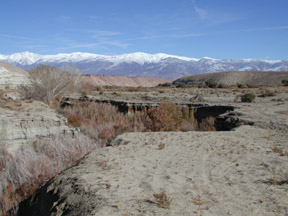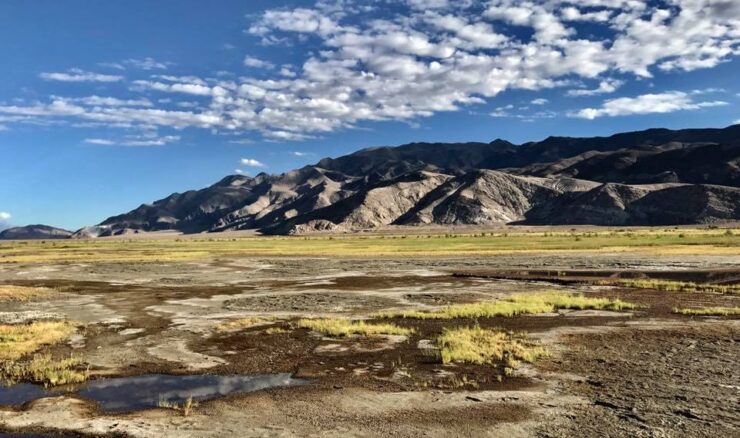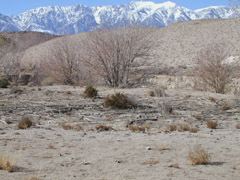What is groundwater?
Delineations between surface water, groundwater, and underground water can be distressingly murky. E.C. Pielou (1998) provides one of the clearest definitions of groundwater when she notes that the word applies “only to water that saturates the ground, filling all the available spaces,” or to water within the saturated zone, the upper boundary of which is known as the water table.
 |
|
| Headcuts (such as this one in the Owens Valley) can drop groundwater levels. Note differences in vegetation on the banks versus the bottom of the headcut. |
The water table can be continuous with the surface (in marshes or swamps, for example), but in the Owens Valley there is often an unsaturated zone between groundwater and the surface– an area in which some air pockets exist or in which there might even be hardly any water. The amount of water (known as vadose water) in this unsaturated area, the permeability of the soil, and the depth of the water table (the distance between the ground’s surface and the upper boundary of the saturated zone) all have a distinct effect on the types, sizes, and numbers of plants growing above ground.
How does it get there?

Although there are bodies of fossil groundwater (water trapped in ancient sediments) and juvenile water (water released by subterranean molten rock), the water we’re concerned about is meteoric groundwater, or “groundwater that circulates as part of the water cycle” (Pielou 1998). Meteoric groundwater can be recharged by precipitation or by surface water that percolates through the unsaturated zone and eventually reaches the water table.
The Owens Valley receives little precipitation. For example, from 1993 to 2002 average annual precipitation in the Owens Valley ranged from one inch to seven inches (Inyo County Water Department 2003). Consequently, living organisms in the Owens Valley depend primarily on surface water and groundwater from snowmelt in the eastern Sierra Nevada and the western White-Inyo mountains.
That water can join groundwater reserves by percolating down through alluvial fans at the bases of the Sierra Nevada and White-Inyo ranges, by joining creeks or tributaries of the Owens River and then seeping from stream or river beds, or even by seeping from aqueducts or flowing from other groundwater systems (Danskin 1998).
The rate at which groundwater tables recharge depends not only upon the permeability of the soil and how much water enters the system, but also upon how moist the soil is (the drier the soil, the more water and time required) and how quickly water becomes available. For example, water from a heavy rainstorm might accumulate too rapidly to percolate through the soil and might instead be carried away by rivers, canals, or aqueducts; water from a light rainstorm might not even saturate surface soil and might evaporate too quickly to reach the water table.
Too many straws
 |
|
| Water table drops, ORV use, and grazing can combine to cause significant changes in vegetation. Native vegetation here (remnants in foreground) has all but disappeared; Russian thistle has moved in. |
The primary source of Owens Valley groundwater was originally snowmelt from surrounding mountain ranges that reached the valley via surface and underground water flow. The Los Angeles Department of Water and Power’s surface water diversions (especially the diversion of the lower Owens River in 1913) crippled this recharge system, although some groundwater was and is replaced via irrigation and seepage from canals.
In the early 1970s Owens Valley groundwater reserves suffered another major blow when LADWP diverted even more surface water and began to pump several hundred thousand acre feet of water a year from groundwater reserves, resulting in changes to Owens Valley vegetation and the disappearance of many Owens Valley springs (Danskin, 1998). Later reductions in groundwater pumping allowed groundwater levels to rise somewhat from their lowest levels, but Owens Valley springs and vegetation have never fully recovered.
Why should I care?

Groundwater depletion can cause drying of springs and seeps, land subsidence, and devastation of local plant communities. These problems can, in turn, affect animals living in the Owens Valley, national and international bird populations, and, ultimately, us.
For example, a well drilled in the wrong place can cause the disappearance of a spring or seep (groundwater flows to the point of least resistance), which in turn causes the death or disappearance of all the plants and animals dependent on that spring for their existence (a factor in the plummet in Owens Valley pupfish populations).
Low groundwater tables can result in the disappearance of entire plant communities and in subsequent dust storms, resulting not only in lunar landscapes (as in the case of the Laws district after excessive groundwater pumping and little irrigation from 1994-2003), but also in increased asthma and health problems for those subjected to the dust. Surface water diversions and groundwater pumping can affect not only the level of the groundwater table, but also the existence of lakes, springs, seeps, and rivers, which in turn can eliminate vital rest stops and nesting and feeding areas for birds and other animals migrating through or living in the Owens Valley.
Learn more
See an excellent discussion of groundwater dependent ecosystems on the web
Download our groundwater brochure
See “Desertification as usual: groundwater management under the Inyo-LA Long Term Water Agreement”
See a discussion of specific groundwater pumping issues on our “Take Action” page
See what we’ve said about previous LADWP pumping plans and the Drought Recovery Policy.
Learn about Inyo County water policy and Owens Valley conditions at the Inyo County Water Department web site
Learn more about surface water, groundwater, water management, and conditions in the Owens Valley from a United States Geological Survey Report (Danskin 1998) that analyzed the sustainability of groundwater pumping
See the latest news about western water issues at High Country News
Learn about water issues and policy from the Water Education Foundation
Peruse our suggested reading list.
References and a brief reading list
Danskin, W.R. 1998. Evaluation of the Hydrologic System and Selected Water-Management Alternatives in the Owens Valley, California. U.S. Geological Survey Water-Supply Paper 2370-H. Hydrology and Soil-Water-Plant Relations in Owens Valley, California. Downloaded November 17, 2003 from
Manning, S. 2003. Owens Valley Precipitation. The Owens Valley Monitor 2002-2003. Inyo County Water Department. Downloaded November 17, 2003 from Outwater, A. 1996. Water: A Natural History. New York: Basic Books.
Pielou, E.C. 1998. Fresh Water. Chicago: The University of Chicago Press.
Reisner, M. 1993. Cadillac Desert. New York: Penguin Books.
Reisner, M. and Bates, S. 1990. Overtapped Oasis. Washington, D.C.: Island Press.
Rothfeder, J. 2001. Every Drop for Sale. New York: Penguin Putnam Inc.

